Answers to Capacitance
Return to Higher Physics past paper index page.
Charge, Voltage and Capacitance
1. C = 40x10-4F = 4000mF
2. C = 3x10-5F = 30mF
3. Q = 7.52x10-4C = 752mC
4. Pd = 12V
5. Pd = 9.1V
6. I = 3x10-6A = 3mA
7. A (1996 PI Q17)
8. D (1995 PI Q17)
9. B (1997 PI Q16)
10. D (1999 PI Q18)
11.i. Q = 90x10-4C = 9000mC
ii. The voltage across the larger capacitor will
be less.
V = Q/C
The charge is the same in each case but as the value of
C increases V must decrease.
Energy Stored in a Capacitor (Pages 2-5)
12. E = 1.5J
13. Pd = 1,500V
14. Q = 3x10-3C = 3mC
15. E = 3x10-3J = 3mJ
16. Pd = 19.1V
17. Q = 43.4-3C = 43.4mC
18. P = 125W
19. A (1994 PI Q17)
20. D (1995 PI Q18)
21. C (1999 PI Q19)
22. E (1996 PI Q18)
23.i.(A) Q = 0.096C (1997 PII Q7b)
(B) E = 288J
ii. I = 48A
Charging and Discharging Graphs
24. E (1992 PI Q20)
25. E (1995 PI Q19)
26. B (1993 PI Q18)
27. C (1994 PI Q16)
28. Position B
29. Position A
30.
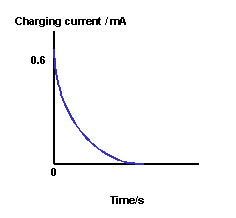 31.
31.
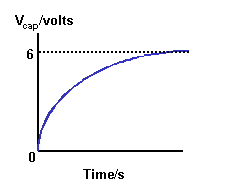 32. Imax(charging) = 6x10-4A = 0.6mA
33. Vcap(final) = 6V
34. Q = 0.012C = 12mC
35.
32. Imax(charging) = 6x10-4A = 0.6mA
33. Vcap(final) = 6V
34. Q = 0.012C = 12mC
35.
 36.
36.
 37. Imax(discharging) = 3x10-4A = 0.3mA
38.
37. Imax(discharging) = 3x10-4A = 0.3mA
38.
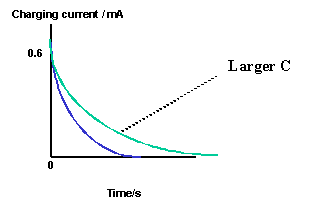 39. B
40A.i. When Vcap reaches 100V the capacitor discharges
through the neon lamp. This continues until the voltage
across the lamp falls to 80V. During this phase the lamp
is ON.
ii. The capacitor then starts to charge and the voltage across
it increases until it reaches 100V. During this phase the
lamp is OFF.
iii. Back to step i above.
B.
39. B
40A.i. When Vcap reaches 100V the capacitor discharges
through the neon lamp. This continues until the voltage
across the lamp falls to 80V. During this phase the lamp
is ON.
ii. The capacitor then starts to charge and the voltage across
it increases until it reaches 100V. During this phase the
lamp is OFF.
iii. Back to step i above.
B.
 C. Reduce R or C.
RC Circuit Analysis
41. No initial charge on the capacitor.
42. No initial voltage across the capacitor. VC = 0V
43. VR = 10V
44. Imax = 1x10-6A = 1mA
45. VC(final) = 10V
46. The current in the circuit is determined by the
voltage across the resistor. As this voltage decreases
as the voltage acoss the copacitor increases, during
charging, the current in the circuit must decrease.
47. As the charging current decreases the rate at which
charge is added to the capacitor also decreases. This
reduces the rate VC increases.(DVC = DQ/C)
48.
C. Reduce R or C.
RC Circuit Analysis
41. No initial charge on the capacitor.
42. No initial voltage across the capacitor. VC = 0V
43. VR = 10V
44. Imax = 1x10-6A = 1mA
45. VC(final) = 10V
46. The current in the circuit is determined by the
voltage across the resistor. As this voltage decreases
as the voltage acoss the copacitor increases, during
charging, the current in the circuit must decrease.
47. As the charging current decreases the rate at which
charge is added to the capacitor also decreases. This
reduces the rate VC increases.(DVC = DQ/C)
48.
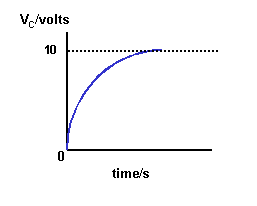 49.
49.
 50. Reverse the change in polarity as often as possible.
This reduces the voltage across the capacitor and
keeps VR and I as high as possible. ( I = VR/R)
51. D
52. VR = 9.5V
53.i. Q = 0.02C (1999 PII Q7bi)
ii. E = 0.360J (1999 PII Q7bii)
54.a. (1998 PII Q6a)
b.i. R = 2x105W (1998 PII Q6bi)
b.ii. (1998 PII Q6bii)
50. Reverse the change in polarity as often as possible.
This reduces the voltage across the capacitor and
keeps VR and I as high as possible. ( I = VR/R)
51. D
52. VR = 9.5V
53.i. Q = 0.02C (1999 PII Q7bi)
ii. E = 0.360J (1999 PII Q7bii)
54.a. (1998 PII Q6a)
b.i. R = 2x105W (1998 PII Q6bi)
b.ii. (1998 PII Q6bii)
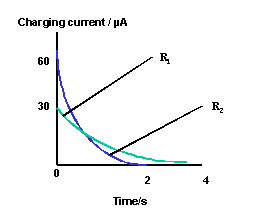 55.i. (1998 PII Q6ci)
ii. (1998 PII Q6cii)
iii. C = 2x10-4F = 200mF (1998 PII Q6ciii)
56.a. (1992 PII Q6a)
55.i. (1998 PII Q6ci)
ii. (1998 PII Q6cii)
iii. C = 2x10-4F = 200mF (1998 PII Q6ciii)
56.a. (1992 PII Q6a)
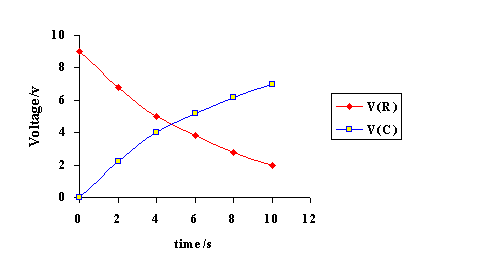 b. I = 441.2mA (1992 PII Q6b)
c.i. E = 40.5mJ (1992 PII Q6ci)
c.ii. Same energy. (1992 PII Q6cii)
57.a.i. Vsupply = 15V (1997 PII Q7ai)
ii. Time = 40s (1997 PII Q7aii)
iii. Vcapacitor = 9V (1997 PII Q7aiii)
Capacitors in AC Circuits
58. C (1996 PI Q20)
59. B (1998 PI Q19)
60. The ratio Vc/Vs will decrease. (1995 PI Q35)
61. (1993 PII Q5b)
62. (1992 PI Q36)
b. I = 441.2mA (1992 PII Q6b)
c.i. E = 40.5mJ (1992 PII Q6ci)
c.ii. Same energy. (1992 PII Q6cii)
57.a.i. Vsupply = 15V (1997 PII Q7ai)
ii. Time = 40s (1997 PII Q7aii)
iii. Vcapacitor = 9V (1997 PII Q7aiii)
Capacitors in AC Circuits
58. C (1996 PI Q20)
59. B (1998 PI Q19)
60. The ratio Vc/Vs will decrease. (1995 PI Q35)
61. (1993 PII Q5b)
62. (1992 PI Q36)
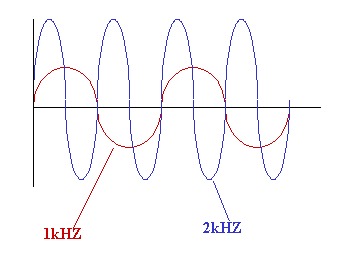 General Questions
63. C (1997 PI Q18)
64.i. C = 16mF (1993 PII Q5ai)
ii. Mean(C) = 17mF (1993 PII Q5aii)
Random error(C) = +-1mF
iii. (1993 PII Q5aiii)
General Questions
63. C (1997 PI Q18)
64.i. C = 16mF (1993 PII Q5ai)
ii. Mean(C) = 17mF (1993 PII Q5aii)
Random error(C) = +-1mF
iii. (1993 PII Q5aiii)
Return to Higher Physics past paper index page.
 31.
31.
 32. Imax(charging) = 6x10-4A = 0.6mA
33. Vcap(final) = 6V
34. Q = 0.012C = 12mC
35.
32. Imax(charging) = 6x10-4A = 0.6mA
33. Vcap(final) = 6V
34. Q = 0.012C = 12mC
35.
 36.
36.
 37. Imax(discharging) = 3x10-4A = 0.3mA
38.
37. Imax(discharging) = 3x10-4A = 0.3mA
38.
 39. B
40A.i. When Vcap reaches 100V the capacitor discharges
through the neon lamp. This continues until the voltage
across the lamp falls to 80V. During this phase the lamp
is ON.
ii. The capacitor then starts to charge and the voltage across
it increases until it reaches 100V. During this phase the
lamp is OFF.
iii. Back to step i above.
B.
39. B
40A.i. When Vcap reaches 100V the capacitor discharges
through the neon lamp. This continues until the voltage
across the lamp falls to 80V. During this phase the lamp
is ON.
ii. The capacitor then starts to charge and the voltage across
it increases until it reaches 100V. During this phase the
lamp is OFF.
iii. Back to step i above.
B.
 C. Reduce R or C.
RC Circuit Analysis
41. No initial charge on the capacitor.
42. No initial voltage across the capacitor. VC = 0V
43. VR = 10V
44. Imax = 1x10-6A = 1mA
45. VC(final) = 10V
46. The current in the circuit is determined by the
voltage across the resistor. As this voltage decreases
as the voltage acoss the copacitor increases, during
charging, the current in the circuit must decrease.
47. As the charging current decreases the rate at which
charge is added to the capacitor also decreases. This
reduces the rate VC increases.(DVC = DQ/C)
48.
C. Reduce R or C.
RC Circuit Analysis
41. No initial charge on the capacitor.
42. No initial voltage across the capacitor. VC = 0V
43. VR = 10V
44. Imax = 1x10-6A = 1mA
45. VC(final) = 10V
46. The current in the circuit is determined by the
voltage across the resistor. As this voltage decreases
as the voltage acoss the copacitor increases, during
charging, the current in the circuit must decrease.
47. As the charging current decreases the rate at which
charge is added to the capacitor also decreases. This
reduces the rate VC increases.(DVC = DQ/C)
48.
 49.
49.
 50. Reverse the change in polarity as often as possible.
This reduces the voltage across the capacitor and
keeps VR and I as high as possible. ( I = VR/R)
51. D
52. VR = 9.5V
53.i. Q = 0.02C (1999 PII Q7bi)
ii. E = 0.360J (1999 PII Q7bii)
54.a. (1998 PII Q6a)
b.i. R = 2x105W (1998 PII Q6bi)
b.ii. (1998 PII Q6bii)
50. Reverse the change in polarity as often as possible.
This reduces the voltage across the capacitor and
keeps VR and I as high as possible. ( I = VR/R)
51. D
52. VR = 9.5V
53.i. Q = 0.02C (1999 PII Q7bi)
ii. E = 0.360J (1999 PII Q7bii)
54.a. (1998 PII Q6a)
b.i. R = 2x105W (1998 PII Q6bi)
b.ii. (1998 PII Q6bii)
 55.i. (1998 PII Q6ci)
ii. (1998 PII Q6cii)
iii. C = 2x10-4F = 200mF (1998 PII Q6ciii)
56.a. (1992 PII Q6a)
55.i. (1998 PII Q6ci)
ii. (1998 PII Q6cii)
iii. C = 2x10-4F = 200mF (1998 PII Q6ciii)
56.a. (1992 PII Q6a)
 b. I = 441.2mA (1992 PII Q6b)
c.i. E = 40.5mJ (1992 PII Q6ci)
c.ii. Same energy. (1992 PII Q6cii)
57.a.i. Vsupply = 15V (1997 PII Q7ai)
ii. Time = 40s (1997 PII Q7aii)
iii. Vcapacitor = 9V (1997 PII Q7aiii)
Capacitors in AC Circuits
58. C (1996 PI Q20)
59. B (1998 PI Q19)
60. The ratio Vc/Vs will decrease. (1995 PI Q35)
61. (1993 PII Q5b)
62. (1992 PI Q36)
b. I = 441.2mA (1992 PII Q6b)
c.i. E = 40.5mJ (1992 PII Q6ci)
c.ii. Same energy. (1992 PII Q6cii)
57.a.i. Vsupply = 15V (1997 PII Q7ai)
ii. Time = 40s (1997 PII Q7aii)
iii. Vcapacitor = 9V (1997 PII Q7aiii)
Capacitors in AC Circuits
58. C (1996 PI Q20)
59. B (1998 PI Q19)
60. The ratio Vc/Vs will decrease. (1995 PI Q35)
61. (1993 PII Q5b)
62. (1992 PI Q36)
 General Questions
63. C (1997 PI Q18)
64.i. C = 16mF (1993 PII Q5ai)
ii. Mean(C) = 17mF (1993 PII Q5aii)
Random error(C) = +-1mF
iii. (1993 PII Q5aiii)
General Questions
63. C (1997 PI Q18)
64.i. C = 16mF (1993 PII Q5ai)
ii. Mean(C) = 17mF (1993 PII Q5aii)
Random error(C) = +-1mF
iii. (1993 PII Q5aiii)